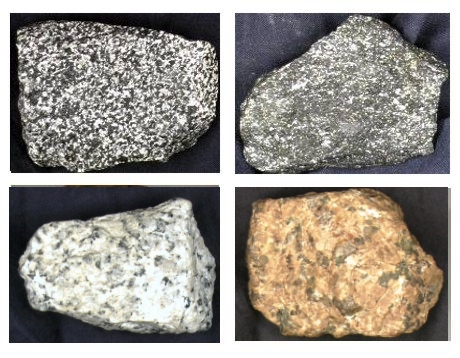| Phaneritic Texture | ||
Examples of Phaneritic Rocks (the three images below show a hand sample, low magnification of a hand sample and a thin section of phaneritic textured rocks)

  |
Phaneritic textured rocks are comprised of large crystals that are clearly visible to the eye with or without a hand lens or binocular microscope. The entire rock is made up of large crystals, which are generally 1/2 mm to several centimeters in size; no fine matrix material is present. This texture forms by slow cooling of magma deep underground in the plutonic environment.  The cartoon sketch above, though highly idealized, attempts to make the point that in order to be truly phaneritic all of the mineral grains must be visible. The beginner often makes the mistake of identifying porphyritic textured (see discussion below) aphanitic rocks as phaneritic. For the more felsic rocks like granite, phaneritic texture is rarely misidentified. But dark rocks like gabrro are more problematic. A good rule of thumb is that fine grained or aphanitic rocks are dull appearing, while phaneritic rocks are brighter or shinier (of course be careful of a glassy rock like obsidian). |
Examples of Phaneritic Rocks

| Aphanitic Texture | ||
Examples of Aphanitic Rocks (the two images below show a hand sample and a thin section of aphanitic textured rocks)

 |
Aphanitic texture consists of small crystals that cannot be seen by the eye with or hand lens. The entire rock is made up of small crystals, which are generally less than 1/2 mm in size. This texture results from rapid cooling in volcanic or hypabyssal (shallow subsurface) environments.  Yes, I know the cartoon above is rather crude, but it gets the point across. Aphanitic rocks are characterized by textures in which the mineral grains are not visible to the eye so they generally look rather like a blank slate. Of course, this represents an ideal world. Most aphanitic rocks will have at least a few phenocrysts (larger grains). This often causes the lay person to assume a phaneritic texture, but with a little practice you will find you can quickly distinguish between aphanitic and phaneritic textures. |
Examples of Aphanitic Rocks

| Porphyritic Texture | ||
Porphyritic Rocks (the two images below show a hand sample and a thin section of porphyritic aphanitic textured rocks)

 |
Porphyritic texture is really a subtype, but usage of the term often confuses the beginner. Porphyritic rocks are composed of at least two minerals having a conspicuous (large) difference in grain size. The larger grains are termed phenocrysts and the finer grains either matrix or groundmass (see the drawing below and image to the left). Porphyritic rocks are thought to have undergone two stages of cooling; one at depth where the larger phenocrysts formed and a second at or near the surface where the matrix grains crystallized.  Both aphanitic and phaneritic rocks can be porphyritic, but the former are far more common. Most often the porphritic term is utilized as a modifier. For instance, an andesite with visible phenocrysts of plagioclase feldspar would be termed an andesite porphyry or porphyritic andesite (see photo above). |
| Glassy Texture | ||
|
| Vesicular Texture | ||
|
| Fragmental (Pyroclastic) Texture | ||
|
 Glassy textured igneous rocks are non-crystalline meaning the rock contains no mineral grains. Glass results from cooling that is so fast that minerals do not have a chance to crystallize. This may happen when magma or lava comes into quick contact with much cooler materials near the Earth's surface. Pure volcanic glass is known as obsidian (see photo).
Glassy textured igneous rocks are non-crystalline meaning the rock contains no mineral grains. Glass results from cooling that is so fast that minerals do not have a chance to crystallize. This may happen when magma or lava comes into quick contact with much cooler materials near the Earth's surface. Pure volcanic glass is known as obsidian (see photo).
 This term refers to vesicles (holes, pores, or cavities) within the igneous rock. Vesicles are the result of gas expansion (bubbles), which often occurs during volcanic eruptions. Pumice and scoria are common types of vesicular rocks. The image to the left shows a basalt with vesicles, hence the name "vesicular basalt".
This term refers to vesicles (holes, pores, or cavities) within the igneous rock. Vesicles are the result of gas expansion (bubbles), which often occurs during volcanic eruptions. Pumice and scoria are common types of vesicular rocks. The image to the left shows a basalt with vesicles, hence the name "vesicular basalt".
 We are almost done, I promise. The last textural term is reserved for pyroclastic rocks, those blown out into the atmosphere during violent volcanic eruptiions. These rocks are collectively termed fragmental. If you examine a fragmental volcanic rock closely you can see why. You will note that it is comprised of numerous grains or fragments that have been welded together by the heat of volcanic eruption. If you run your fingers over the rock it will often feel grainy like sandpaper or a sedimentary rock. You might also spot shards of glass embedded in the rock. The terminology for fragmental rocks is voluminous, but most are simply identified as "tuff".
We are almost done, I promise. The last textural term is reserved for pyroclastic rocks, those blown out into the atmosphere during violent volcanic eruptiions. These rocks are collectively termed fragmental. If you examine a fragmental volcanic rock closely you can see why. You will note that it is comprised of numerous grains or fragments that have been welded together by the heat of volcanic eruption. If you run your fingers over the rock it will often feel grainy like sandpaper or a sedimentary rock. You might also spot shards of glass embedded in the rock. The terminology for fragmental rocks is voluminous, but most are simply identified as "tuff".